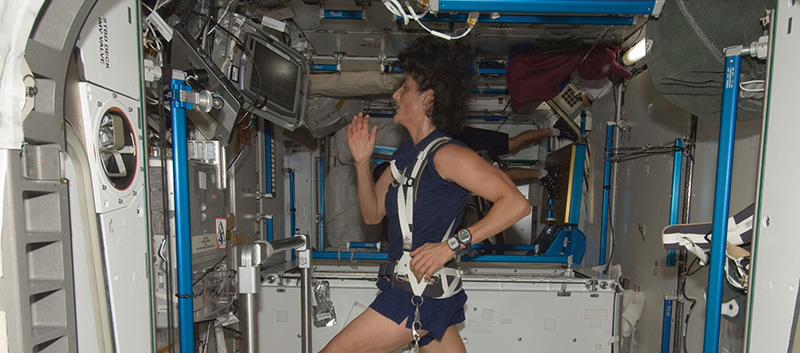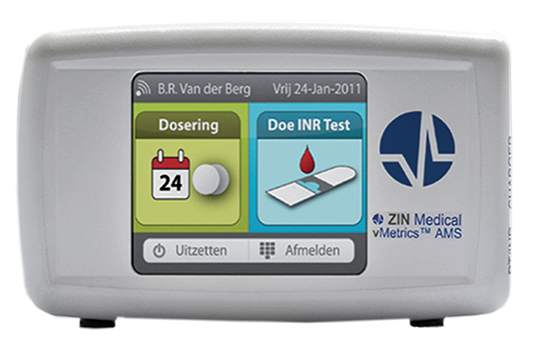
Monitors Enable Medication Management in Patients’ Homes
NASA Technology
To build a small and mobile monitoring and processing system for use onboard the station to capture, store, and transmit sensor data about astronauts back to Earth, Glenn awarded Small Business Innovation Research (SBIR) funding to Cleveland-based ZIN Technologies. Using those funds, ZIN developed a platform that could incorporate various sensors quantifying an astronaut’s health status and then communicate the information to the ground.
“The group developed a prototype that worked,” says Griffin. “The device could go anywhere, and the technology was very adaptable.”
For NASA, the technology could be used for virtually all sensors, thus allowing data collection from any device designed to monitor astronaut performance and health. On Earth, the partners envisioned it being advantageous for doctors to remotely monitor their patients, which is why ZIN partnered with the Cleveland Clinic shortly after demonstrating their first generation hardware.
After obtaining additional funding from Cleveland State University, the Global Cardiovascular Innovation Center, and the Ohio Third Frontier Fund, ZIN developed the technology further and strengthened their relationship with the Cleveland Clinic by forming a new Cleveland-based company called FlexLife Health to commercialize the spinoff technology
Benefits
In late 2012, FlexLife Health launched the first version of the technology called vMetrics. As part of an anti-coagulation management system for people with chronic cardiovascular disease, sensors paired with vMetrics were specifically designed to monitor the levels of anti-clotting agents like warfarin in a patient’s blood. These levels must be closely monitored because if the dosage is too high, there is a risk of bleeding. If the dosage is too low, the medication becomes less effective at preventing a possible blood clot.
According to Frederick J. Mindermann, CEO and president of FlexLife Health, “Monitoring oral anti-coagulation medication can be difficult and time consuming. It requires frequent visits to your physician’s office to have blood drawn, and then wait for the clinician to advise you on the appropriate dosing. Now, there’s a better way to manage your treatment.”
vMetrics enables the monitoring of medication in real time at the patient’s home. After placing a blood sample in a separate testing instrument, data about the sample is automatically sent to the vMetrics device. The device then sends the information to FlexLife’s secure server, where the data is stored and can be accessed by health professionals or transferred to the patient’s electronic medical record.
Using vMetric’s touchscreen, patients and health care professionals can interact—ask and answer questions—and physicians, nurses, or pharmacists can adjust the patient’s dosage if necessary.
“Patients love it because they don’t have to come into the clinic as often,” says Mindermann. “With a system like this, patients don’t have to leave the house as much.” In an increasingly cost-constrained medical system, saving money by avoiding clinic visits is an important benefit as well.
Based on the results of a clinical trial incorporating vMetrics, nearly 83 percent of trial participants reported that the technology made management of their medication easier and/or saved time. For these reasons, Mindermann is optimistic about future applications of the technology to monitor patients across a range of chronic conditions including congestive heart failure, hypertension, diabetes, chronic obstructive pulmonary disease, stroke, myocardial infarction, atrial fibrillation, sleep apnea, and more.
“For someone with congestive heart failure, it is important to monitor weight and heart rate, and to ask questions about daily health,” he says. “vMetrics has an extensive platform that we plan to expand following this initial warfarin work.”
Griffin says he is happy that the space technology is being used on Earth, but he hasn’t ruled out the possibility of using it in space. Even though the current exercise program is more stringent than ever, astronauts continue to experience a certain amount of bone loss in space, and that remains a concern for long-term flights.
vMetrics™ is a trademark of FlexLife Health.

ZIN Technologies developed a device to store and transmit information about astronauts’ health on the ISS. The company then developed the system further and formed FlexLife Health to commercialize the technology as part of an anti-coagulation management system for people with cardiovascular disease.

Adequate exercise is extremely important to help astronauts maintain a healthy amount of bone and muscle mass while in space. Here, astronaut Sunni Williams runs on the first treadmill installed on the International Space Station (ISS).













